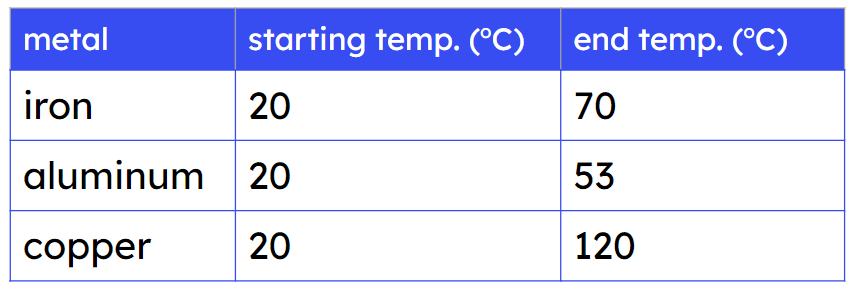Myths about teaching can hold you back
- Year 7
Energy and substance
I can describe differences between the energy of different substances at the same temperature.
- Year 7
Energy and substance
I can describe differences between the energy of different substances at the same temperature.
These resources will be removed by end of Summer Term 2025.
Switch to our new teaching resources now - designed by teachers and leading subject experts, and tested in classrooms.
These resources were created for remote use during the pandemic and are not designed for classroom teaching.
Lesson details
Key learning points
- It is easier to increase the temperature of some materials than others.
- The mass of particles and the attractive forces between particles are different in different substances.
- Different substances need different amounts of heating to reach the same temperature.
- The same amount of different materials at the same temperature can cause different amounts of heating.
- The higher the specific heat capacity, the more energy 1 kg of a substance has, at a temperature, in the thermal store.
Keywords
Heating - when energy transfers from high to low temperature
Specific heat capacity - the property of a material that determines how much energy needs to be transferred to it to increase its temperature
Thermal store - the energy a substance has because of the random motion of its particles
Common misconception
Pupils rarely develop an intuitive understanding of what specific heat capacity means when it is introduced through an equation.
Use this lesson to develop a qualitative understanding of the specific heat capacity of objects, without introducing the equation for specific heat capacity.
To help you plan your year 7 science lesson on: Energy and substance, download all teaching resources for free and adapt to suit your pupils' needs...
To help you plan your year 7 science lesson on: Energy and substance, download all teaching resources for free and adapt to suit your pupils' needs.
The starter quiz will activate and check your pupils' prior knowledge, with versions available both with and without answers in PDF format.
We use learning cycles to break down learning into key concepts or ideas linked to the learning outcome. Each learning cycle features explanations with checks for understanding and practice tasks with feedback. All of this is found in our slide decks, ready for you to download and edit. The practice tasks are also available as printable worksheets and some lessons have additional materials with extra material you might need for teaching the lesson.
The assessment exit quiz will test your pupils' understanding of the key learning points.
Our video is a tool for planning, showing how other teachers might teach the lesson, offering helpful tips, modelled explanations and inspiration for your own delivery in the classroom. Plus, you can set it as homework or revision for pupils and keep their learning on track by sharing an online pupil version of this lesson.
Explore more key stage 3 science lessons from the Heating and cooling unit, dive into the full secondary science curriculum, or learn more about lesson planning.

Equipment
Bunsen burner, tripod, gauze, glass beaker (250 ml), balance, cooking oil, 0–100°C thermometer
Content guidance
- Risk assessment required - equipment
Supervision
Adult supervision required
Licence
Prior knowledge starter quiz
6 Questions
Q1.What is the basic particle theory?
Q2.What is a thermal energy store?
Q3.Which of these cause the energy in the thermal energy store to decrease?
Q4.What happens to the particles a liquid is made of when it is cooled down to a lower temperature?
Q5.Starting with the least energy, put these in order of the energy in their thermal energy store.
Q6.What happens to the energy a cup of tea has in the thermal store as it cools down?
Assessment exit quiz
6 Questions
Q1.What is a pure substance?
Q2.How does heating transfer energy?
Q3.Specific heat capacity is the property of a material that determines how much...
Q4.Why do particles in mixtures move at different speeds?
Q5.Starting with the least energy, put these in order of the energy in their thermal energy store:
Q6.Three metals balls of equal mass are heated in the oven for the same amount of time. Which metal has the lowest specific heat capacity?



